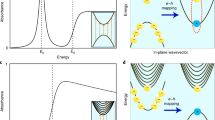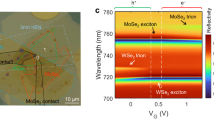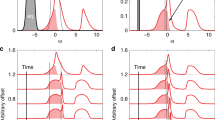Abstract
In neutral dense electron–hole systems at low temperatures, theory predicted Cooper-pair-like excitons exist at the Fermi energy and form a Bardeen–Cooper–Schrieffer-like condensate. Optical excitations create electron–hole systems with the density controlled via the excitation power. However, the intense optical excitations required to achieve high densities cause substantial heating that prevents the realization of simultaneously dense and cold electron–hole systems in conventional semiconductors. Here we show that the separation of electron and hole layers enables the realization of a simultaneously dense and cold electron–hole system. We find a strong enhancement of photoluminescence intensity at the Fermi energy of the neutral dense ultracold electron–hole system that demonstrates the emergence of an excitonic Fermi edge singularity due to the formation of Cooper-pair-like excitons at the Fermi energy. Our measurements also show a crossover from the hydrogen-like excitons to the Cooper-pair-like excitons with increasing density, consistent with the theoretical prediction of a smooth transition.
This is a preview of subscription content, access via your institution
Access options
Access Nature and 54 other Nature Portfolio journals
Get Nature+, our best-value online-access subscription
$29.99 / 30 days
cancel any time
Subscribe to this journal
Receive 12 print issues and online access
$209.00 per year
only $17.42 per issue
Buy this article
- Purchase on Springer Link
- Instant access to full article PDF
Prices may be subject to local taxes which are calculated during checkout




Similar content being viewed by others
Data availability
Source data files are available via Figshare66. All relevant data are available from the authors upon reasonable request.
References
Keldysh, L. V. & Kozlov, A. N. Collective properties of excitons in semiconductors. Sov. Phys. JETP 27, 521–528 (1968).
Keldysh, L. V. & Kopaev, Y. V. Possible instability of the semimetallic state toward Coulomb interaction. Sov. Phys. Solid State 6, 2219–2224 (1965).
Butov, L. V., Kulakovskii, V. D., Lach, E., Forchel, A. & Grützmacher, D. Magnetoluminescence study of many-body effects in homogeneous quasi-two-dimensional electron-hole plasma in undoped InGaAs/InP single quantum wells. Phys. Rev. B 44, 10680–10688 (1991).
High, A. A. et al. Indirect excitons in elevated traps. Nano Lett. 9, 2094–2098 (2009).
Mahan, G. D. Excitons in degenerate semiconductors. Phys. Rev. 153, 882–889 (1967).
Combescot, M. & Noziéres, P. Infrared catastrophy and excitons in the X-ray spectra of metals. J. de Phys. 32, 913–929 (1971).
Skolnick, M. S. et al. Observation of a many-body edge singularity in quantum-well luminescence spectra. Phys. Rev. Lett. 58, 2130–2133 (1987).
Lee, J. S., Iwasa, Y. & Miura, N. Observation of the Fermi edge anomaly in the absorption and luminescence spectra of n-type modulation-doped GaAs–AlGaAs quantum wells. Semicond. Sci. Technol. 2, 675–678 (1987).
Livescu, A. et al. Free carrier and many-body effects in absorption spectra of modulation-doped quantum wells. IEEE J. Quantum Electron. 24, 1677–1689 (1988).
Ohtaka, K. & Tanabe, Y. Golden-rule approach to the soft-x-ray-absorption problem. V. Thermal broadening and comparison with experiments in quantum wells. Phys. Rev. B 39, 3054–3064 (1989).
Uenoyama, T. & Sham, L. J. Effect of finite hole mass on edge singularities in optical spectra. Phys. Rev. Lett. 65, 1048–1051 (1990).
Hawrylak, P. Optical properties of a two-dimensional electron gas: evolution of spectra from excitons to Fermi-edge singularities. Phys. Rev. B 44, 3821–3828 (1991).
Butov, L. V., Egorov, V. D., Kulakovskii, V. D. & Anderson, T. G. Magnetoluminescence study of many-body effects in a dense electron-hole plasma of strained InxGa1−xAs/GaAs quantum wells. Phys. Rev. B 46, 15156–15162 (1992).
Kappei, L., Szczytko, J., Morier-Genoud, F. & Deveaud, B. Direct observation of the Mott transition in an optically excited semiconductor quantum well. Phys. Rev. Lett. 94, 147403 (2005).
Lozovik, Y. E. & Yudson, V. I. A new mechanism for superconductivity: pairing between spatially separated electrons and holes. Sov. Phys. JETP 44, 389–397 (1976).
Butov, L. V. et al. Stimulated scattering of indirect excitons in coupled quantum wells: signature of a degenerate Bose-gas of excitons. Phys. Rev. Lett. 86, 5608–5611 (2001).
Yoshioka, D. & MacDonald, A. H. Double quantum well electron-hole systems in strong magnetic fields. J. Phys. Soc. Jpn 59, 4211–4214 (1990).
Zhu, X., Littlewood, P. B., Hybertsen, M. & Rice, T. Exciton condensate in semiconductor quantum well structures. Phys. Rev. Lett. 74, 1633–1636 (1995).
Lozovik, Y. E. & Berman, O. L. Phase transitions in a system of spatially separated electrons and holes. JETP 84, 1027–1035 (1997).
Ben-Tabou de-Leon, S. & Laikhtman, B. Exciton-exciton interactions in quantum wells: optical properties and energy and spin relaxation. Phys. Rev. B 63, 125306 (2001).
Keldysh, L. V. The electron–hole liquid in semiconductors. Contemp. Phys. 27, 395–428 (1986).
Zrenner, A. et al. Indirect excitons in coupled quantum well structures. Surf. Sci. 263, 496–501 (1992).
Vörös, Z., Balili, R., Snoke, D. W., Pfeiffer, L. & West, K. Long-distance diffusion of excitons in double quantum well structures. Phys. Rev. Lett. 94, 226401 (2005).
Gärtner, A., Holleitner, A. W., Kotthaus, J. P. & Schuh, D. Drift mobility of long-living excitons in coupled GaAs quantum wells. Appl. Phys. Lett. 89, 052108 (2006).
Fogler, M. M., Yang, S., Hammack, A. T., Butov, L. V. & Gossard, A. C. Effect of spatial resolution on the estimates of the coherence length of excitons in quantum wells. Phys. Rev. B 78, 035411 (2008).
High, A. A. et al. Spontaneous coherence in a cold exciton gas. Nature 483, 584–588 (2012).
Alloing, M. et al. Evidence for a Bose–Einstein condensate of excitons. Europhys. Lett. 107, 10012 (2014).
Stern, M., Umansky, V. & Bar-Joseph, I. Exciton liquid in coupled quantum wells. Science 343, 55–57 (2014).
Lazić, S. et al. Scalable interconnections for remote indirect exciton systems based on acoustic transport. Phys. Rev. B 89, 085313 (2014).
Fedichkin, F. et al. Transport of dipolar excitons in (Al,Ga)N/GaN quantum wells. Phys. Rev. B 91, 205424 (2015).
Cohen, K. et al. Dipolar liquid of excitons. Nano Lett. 16, 3726–3731 (2016).
Gorbunov, A. V. & Timofeev, V. B. Coherence of Bose–Einstein condensates of dipolar excitons in GaAs/AlGaAs heterostructures. Low. Temp. Phys. 42, 340–346 (2016).
Leonard, J. R. et al. Moiré pattern of interference dislocations in condensate of indirect excitons. Nat. Commun. 12, 1175 (2021).
Sivalertporn, K., Mouchliadis, L., Ivanov, A. L., Philp, R. & Muljarov, E. A. Direct and indirect excitons in semiconductor coupled quantum wells in an applied electric field. Phys. Rev. B 85, 045207 (2012).
Comte, C. & Noziéres, P. Exciton Bose condensation: the ground state of an electron–hole gas – I. Mean field description of a simplified model. J. de Phys. 43, 1069–1081 (1982).
Choksy, D. J. et al. Attractive and repulsive dipolar interaction in bilayers of indirect excitons. Phys. Rev. B 103, 045126 (2021).
De Palo, S., Rapisarda, F. & Senatore, G. Excitonic condensation in a symmetric electron–hole bilayer. Phys. Rev. Lett. 88, 206401 (2002).
Schleede, J., Filinov, A., Bonitz, M. & Fehske, H. Phase diagram of bilayer electron–hole plasmas. Contrib. Plasma Phys. 52, 819–826 (2012).
Maezono, R., Ríos, P. L., Ogawa, T. & Needs, R. J. Excitons and biexcitons in symmetric electron–hole bilayers. Phys. Rev. Lett. 110, 216407 (2013).
Fogler, M. M., Butov, L. V. & Novoselov, K. S. High-temperature superfluidity with indirect excitons in van der Waals heterostructures. Nat. Commun. 5, 4555 (2014).
Dignam, M. M. & Sipe, J. E. Exciton states in coupled double quantum wells in a static electric field. Phys. Rev. B 43, 4084–4096 (1991).
Skocpol, W. J. & Tinkham, M. Fluctuations near superconducting phase transitions. Rep. Prog. Phys. 38, 1049–1097 (1975).
Aslamazov, L. G. & Larkin, A. I. Effect of fluctuations on properties of a superconductor above critical temperature. Sov. Phys. Solid State 10, 875–880 (1968).
Schmitt-Rink, S., Ell, C. & Haug, H. Many-body effects in the absorption, gain, and luminescence spectra of semiconductor quantum-well structures. Phys. Rev. B 33, 1183–1189 (1986).
Des Cloizeaux, J. Exciton instability and crystallographic anomalies in semiconductors. J. Phys. Chem. Solids 26, 259–266 (1965).
Kozlov, A. N. & Maksimov, L. A. The metal–dielectric divalent crystal phase transition. Sov. Phys. JETP 21, 790–795 (1965).
Jerome, D., Rice, T. M. & Kohn, W. Excitonic insulator. Phys. Rev. 158, 462–475 (1967).
Halperin, B. I. & Rice, T. M. The excitonic state at the semiconductor–semimetal transition. Solid State Phys. 21, 115–192 (1968).
Eisenstein, J. P. & MacDonald, A. H. Bose–Einstein condensation of excitons in bilayer electron systems. Nature 432, 691–694 (2004).
Rontani, M. & Sham, L. J. Coherent transport in a homojunction between an excitonic insulator and semimetal. Phys. Rev. Lett. 94, 186404 (2005).
Du, L. et al. Evidence for a topological excitonic insulator in InAs/GaSb bilayers. Nat. Commun. 8, 1971 (2017).
Kogar, A. et al. Signatures of exciton condensation in a transition metal dichalcogenide. Science 358, 1314–1317 (2017).
Liu, X., Watanabe, K., Taniguchi, T., Halperin, B. I. & Kim, P. Quantum Hall drag of exciton condensate in graphene. Nat. Phys. 13, 746–750 (2017).
Li, J. I. A., Taniguchi, T., Watanabe, K., Hone, J. & Dean, C. R. Excitonic superfluid phase in double bilayer graphene. Nat. Phys. 13, 751–755 (2017).
Burg, G. W. et al. Strongly enhanced tunneling at total charge neutrality in double-bilayer graphene-WSe2 heterostructures. Phys. Rev. Lett. 120, 177702 (2018).
Sun, Z., Kaneko, T., Golež, D. & Millis, A. J. Second-order Josephson effect in excitonic insulators. Phys. Rev. Lett. 127, 127702 (2021).
Ataei, S. S., Varsano, D., Molinari, E. & Rontani, M. Evidence of ideal excitonic insulator in bulk MoS2 under pressure. Proc. Natl Acad. Sci. USA 118, e2010110118 (2021).
Kim, K. et al. Direct observation of excitonic instability in Ta2NiSe5. Nat. Commun. 12, 1969 (2021).
Liu, X. et al. Crossover between strongly coupled and weakly coupled exciton superfluids. Science 375, 205–209 (2022).
Jia, Y. et al. Evidence for a monolayer excitonic insulator. Nat. Phys. 18, 87–93 (2022).
Sun, B. et al. Evidence for equilibrium exciton condensation in monolayer WTe2. Nat. Phys. 18, 94–99 (2022).
Gu, J. et al. Dipolar excitonic insulator in a moiré lattice. Nat. Phys. 18, 395–400 (2022).
Zhang, Z. et al. Correlated interlayer exciton insulator in heterostructures of monolayer WSe2 and moiré WS2/WSe2. Nat. Phys. https://doi.org/10.1038/s41567-022-01702-z (2022).
Chen, D. et al. Excitonic insulator in a heterojunction moiré superlattice. Nat. Phys. https://doi.org/10.1038/s41567-022-01703-y (2022).
Zwierlein, M. W., Abo-Shaeer, J. R., Schirotzek, A., Schunck, C. H. & Ketterle, W. Vortices and superfluidity in a strongly interacting Fermi gas. Nature 435, 1047–1051 (2005).
Choksy, D. J., Szwed, E. A., Butov, L. V., Baldwin, K. W. & Pfeiffer, L. N. Data for Fermi edge singularity in neutral electron–hole system paper. Figshare https://figshare.com/s/513eebd7af01900af912 (2023).
Acknowledgements
We thank M. Fogler, L. Fowler-Gerace, J. Leonard, L. Sham and B. Vermilyea for discussions. The spectroscopy studies were supported by NSF grant no. 1905478 (L.V.B.). The coherence studies were supported by DOE Office of Basic Energy Sciences under award no. DE-FG02-07ER46449 (L.V.B.). The heterostructure growth was funded by the Gordon and Betty Moore Foundation’s EPiQS Initiative, grant GBMF9615 to L.N.P., and by National Science Foundation MRSEC grant DMR 2011750 to Princeton University.
Author information
Authors and Affiliations
Contributions
L.V.B. designed the project. K.W.B. and L.N.P. grew the GaAs heterostructures. D.J.C. and E.A.S. performed the measurements. D.J.C., E.A.S. and L.V.B. analysed the data. L.V.B. wrote the manuscript with inputs from all the authors.
Corresponding author
Ethics declarations
Competing interests
The authors declare no competing interests.
Peer review
Peer review information
Nature Physics thanks the anonymous reviewers for their contribution to the peer review of this work.
Additional information
Publisher’s note Springer Nature remains neutral with regard to jurisdictional claims in published maps and institutional affiliations.
Supplementary information
Supplementary Information
Supplementary discussion with figures.
Rights and permissions
Springer Nature or its licensor (e.g. a society or other partner) holds exclusive rights to this article under a publishing agreement with the author(s) or other rightsholder(s); author self-archiving of the accepted manuscript version of this article is solely governed by the terms of such publishing agreement and applicable law.
About this article
Cite this article
Choksy, D.J., Szwed, E.A., Butov, L.V. et al. Fermi edge singularity in neutral electron–hole system. Nat. Phys. 19, 1275–1279 (2023). https://doi.org/10.1038/s41567-023-02096-2
Received:
Accepted:
Published:
Issue Date:
DOI: https://doi.org/10.1038/s41567-023-02096-2
This article is cited by
-
Fermi edge singularity in neutral electron–hole system
Nature Physics (2023)



